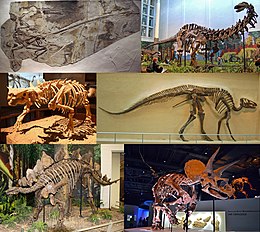
Back Dinosourus Afrikaans Dinosaurier ALS ኃያል እንሽላሊት Amharic Dinosauria AN डायनासोर ANP ديناصور Arabic ديناصور ARY ديناصور ARZ ডাইন’চৰ Assamese Dinosauriu AST
| Dinosaur Temporal range: (Possible Middle Triassic record)
| |
|---|---|

| |
| A collection of fossil dinosaur skeletons. Clockwise from top left: Microraptor (a winged theropod), Apatosaurus (a giant sauropod), Edmontosaurus (a duck-billed ornithopod), Triceratops (a horned ceratopsian), Stegosaurus (a plated stegosaur), Pinacosaurus (an armored ankylosaur) | |
| Scientific classification | |
| Domain: | Eukaryota |
| Kingdom: | Animalia |
| Phylum: | Chordata |
| Clade: | Dracohors |
| Clade: | Dinosauria Owen, 1842 |
| Major groups | |
Dinosaurs are a group of Archosaur reptiles of the clade Dinosauria.[1] Dinosaurs eventually gave rise to birds.
Dinosaurs were the most powerful land animals of the Mesozoic era. Over 500 different genera of dinosaurs are known.[2] Fossils of dinosaurs have been found on every continent.
Dinosaurs began in the Upper Triassic, about 230 million years ago (mya).[3] The earliest date of a dinosaur fossil is that of Eoraptor and Herrerasaurus from Argentina, and Saturnalia from Brazil, 237 to 228 mya.[4]
By the early Jurassic they were the top land vertebrates, and dominated most environments on land. They continued until the K/T extinction event 66 million years ago.[5]
From the fossil record, it is known that birds are living feathered dinosaurs.[6] They evolved from earlier theropods during the later Jurassic.[7] They were the only line of dinosaurs to survive to the present day.[8]
Dinosaurs had adaptations that helped make them successful. The first known dinosaurs were small predators that walked on two legs.[9][10] All their descendants had an upright posture, with the legs underneath the body. This transformed their whole life-style. Most of the smaller dinosaurs had feathers, and were probably warm-blooded. This would make them active, with a higher metabolism than modern reptiles. Social interaction, with living in herds and co-operation, seems certain for some types. The existence of communal egg-laying sites is best understood if the adults travelled in herds, as herbivores do today.
The first fossils were recognised as dinosaurs in the early 19th century. Some of their bones were found much earlier, but were not understood. William Buckland, Gideon Mantell and Richard Owen saw these bones were a special group of animals. Georges Cuvier was also important in explaining what dinosaurs were. Dinosaurs are now major attractions at museums around the world. They have become part of popular culture. There have been best-sellng books and movies about dinosaurs. New discoveries are reported in the media.

- ↑ The word 'dinosaur' comes from Greek, meaning 'terrible lizard, ["Dinosaurs - What's in a name?". Children's BBC. 26 October 2001. Retrieved 2009-10-03.] and was coined by English biologist Richard Owen in 1842. ["Richard Owen". Natural History Museum. Retrieved 2009-10-05.]
- ↑ That is, fossil dinosaurs and not modern birds.
- ↑ They may have began earlier: Alcobar, Oscar A.; Martinez, Ricardo N. (19 October 2010). "A new herrerasaurid (Dinosauria, Saurischia) from the Upper Triassic Ischigualasto Formation of northwestern Argentina". ZooKeys (63): 55–81. doi:10.3897/zookeys.63.550. ISSN 1313-2970. PMC 3088398. PMID 21594020.
- ↑ Benton M.J. 2015. Vertebrate palaeontology. 4th ed, Wiley Blackwell, p205.
- ↑ "Dino Timeline". Natural History Museum. Retrieved 2009-10-05.
- ↑ St. Fleur, Nicholas (8 December 2016). "That thing with feathers trapped in amber? It was a dinosaur tail". New York Times. Retrieved 8 December 2016.
- ↑ "Sustained miniaturization and anatomical innovation in the dinosaurian ancestors of birds". Science. 345 (6196): 562–566. 1 August 2014. Bibcode:2014Sci...345..562L. doi:10.1126/science.1252243. PMID 25082702. S2CID 37866029. Retrieved August 2, 2014.
{{cite journal}}: Cite uses deprecated parameter|authors=(help) - ↑ Holtz, Thomas R. Jr. (2007). Dinosaurs: the most complete, up-to-date encyclopedia for dinosaur lovers of all ages. New York: Random House. ISBN 978-0-375-82419-7.
- ↑ Cite error: The named reference
Paleoswas used but no text was provided for refs named (see the help page). - ↑ Moderately large bipedal dinosauromorphs had appeared by 246 mya. Fossil tracks show that the dinosaur lineage appeared soon after the Permian-Triassic extinction event. Their age suggests that the rise of dinosaurs was slow and drawn out across much of the Triassic. Brusatte S.L; Niedźwiedzki G. & Butler R.J. 2010 (2011). "Footprints pull origin and diversification of dinosaur stem lineage deep into early Triassic". Proceedings of the Royal Society B. 278 (1708): 1107–1113. doi:10.1098/rspb.2010.1746. PMC 3049033. PMID 20926435.
{{cite journal}}: CS1 maint: multiple names: authors list (link) CS1 maint: numeric names: authors list (link)